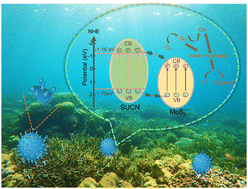Graphitic carbon nitride (CN) is considered to be a promising metal-free photocatalyst, but the charge carrier separation and rapid complexation of electrons and holes are difficult to modulate for effective and comprehensive photodegradation of TC. In this work, a MoS2 QD decorated sea-urchin carbon nitride nanohybrid was prepared via a water bath method. In comparison to the 85.6% degradation efficiency of sole sea-urchin carbon nitride (SUCN), the optimized 5% MoS2 QDs/SUCN (5%MSUCN) demonstrated a removal efficiency of 96.0% towards aqueous tetracycline (TC) under visible light. Such an outstanding photoactivity was mainly attributed to the interfacial synergistic effect of MoS2 QDs and SUCN, in which the outstanding charge extraction ability and quick surface kinetics of MoS2 QDs were primarily accountable for the subsequent deep photodegradation behavior of 5%MSUCN. A series of factors that may affect photoactivity of 5%MSUCN include pH values, inorganic ions, and organic matter. Finally, the deep photodegradation mechanisms of TC and intermediates were proposed based on ex situ HPLC-MS. This work not only explains the deep decomposition of TC but also presents a facile approach for designing and manufacturing carbon nitride nanohybrids.

